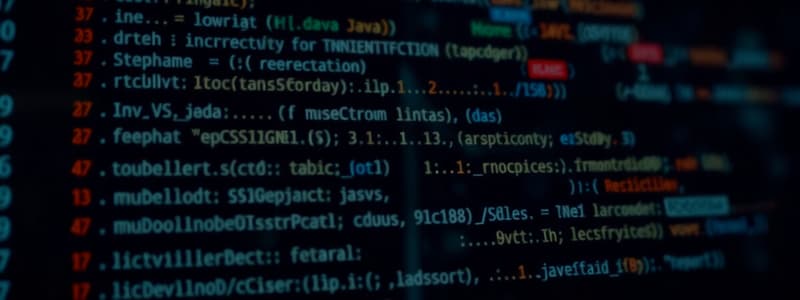Podcast
Questions and Answers
What is the valid range of indices for an array with 12 elements?
What is the valid range of indices for an array with 12 elements?
- 0 to 11 (correct)
- 1 to 12
- 0 to 12
- 1 to 11
Which notation is used to initialize an array of integers with specific values?
Which notation is used to initialize an array of integers with specific values?
- new int[12] {31,28,31,30,31,30,31,31,30,31,30,31}
- int[] monthSize = {31,28,31,30,31,30,31,31,30,31,30,31} (correct)
- int[12] monthSize = {31,28,31,30,31,30,31,31,30,31,30,31}
- int[] monthSize = new int[] {31,28,31,30,31,30,31,31,30,31,30,31}
What should be avoided when working with arrays as indicated in the content?
What should be avoided when working with arrays as indicated in the content?
- Initializing arrays during declaration
- Declaring arrays with less than 5 elements
- Using separate, parallel arrays (correct)
- Accessing array elements using their index
Which of the following is a correct way to declare an array of size 10 for storing bytes?
Which of the following is a correct way to declare an array of size 10 for storing bytes?
What method can be used to access the third element of an array named scores?
What method can be used to access the third element of an array named scores?
What type of conversion occurs when a smaller data type is converted to a larger data type in Java?
What type of conversion occurs when a smaller data type is converted to a larger data type in Java?
What happens to the variable scope when a variable is declared within a method?
What happens to the variable scope when a variable is declared within a method?
Which operator will increment the value of a variable and return the new value?
Which operator will increment the value of a variable and return the new value?
What type of scopes are established when variables are declared inside a loop or conditional structure?
What type of scopes are established when variables are declared inside a loop or conditional structure?
What does the shorthand operator 'x += y' do?
What does the shorthand operator 'x += y' do?
In Java, what is the result type when performing arithmetic between an int and a float?
In Java, what is the result type when performing arithmetic between an int and a float?
When a variable's access modifier is changed, what aspect of its visibility is affected?
When a variable's access modifier is changed, what aspect of its visibility is affected?
Which of the following data types can be assigned a value without explicit casting when using widening conversion?
Which of the following data types can be assigned a value without explicit casting when using widening conversion?
What will happen if an array index exceeds its bounds?
What will happen if an array index exceeds its bounds?
How can the index error in a for loop that traverses an array be prevented?
How can the index error in a for loop that traverses an array be prevented?
Which statement about array declaration in Java is true?
Which statement about array declaration in Java is true?
What happens to uninitialized arrays in Java?
What happens to uninitialized arrays in Java?
Which method is used to create a defensive copy of an array in Java?
Which method is used to create a defensive copy of an array in Java?
What does the Arrays.copyOf() method require as its first argument?
What does the Arrays.copyOf() method require as its first argument?
When is it most necessary to make a defensive copy of an array?
When is it most necessary to make a defensive copy of an array?
If an array is loaded but remains uninitialized, what state will its elements have?
If an array is loaded but remains uninitialized, what state will its elements have?
Flashcards
Loop Boundary Testing
Loop Boundary Testing
Testing a loop by evaluating the code's behavior at the start and end values of the loop to verify proper operation.
Array
Array
A data structure storing a sequential set of variables of the same data type.
Array Element Access
Array Element Access
Accessing an array element by its index number (position).
Array Index
Array Index
Signup and view all the flashcards
Array Initialization
Array Initialization
Signup and view all the flashcards
Data types float and double
Data types float and double
Signup and view all the flashcards
BigDecimal class
BigDecimal class
Signup and view all the flashcards
Variable scope
Variable scope
Signup and view all the flashcards
Local scope
Local scope
Signup and view all the flashcards
Widening conversion
Widening conversion
Signup and view all the flashcards
Implicit type conversion
Implicit type conversion
Signup and view all the flashcards
Prefix operator (++ or --)
Prefix operator (++ or --)
Signup and view all the flashcards
Postfix operator (++ or --)
Postfix operator (++ or --)
Signup and view all the flashcards
Array bounds
Array bounds
Signup and view all the flashcards
ArrayOutOfBoundsException
ArrayOutOfBoundsException
Signup and view all the flashcards
Array size
Array size
Signup and view all the flashcards
Defensive Copy (Arrays)
Defensive Copy (Arrays)
Signup and view all the flashcards
Arrays.copyOf()
Arrays.copyOf()
Signup and view all the flashcards
Array Declaration
Array Declaration
Signup and view all the flashcards
Array reference
Array reference
Signup and view all the flashcards
Study Notes
Introduction to Computer Programming (Algonquin College) - Final Exam Summary
- Data Types: Java data types are classified as either primitive or reference types. Primitive types store values directly in memory, while reference types use references/IDs.
- Primitive Types: These types are always lowercase and characterized by size, range, precision and format. Examples include boolean, char, byte, short, int, long, float, and double.
- Reference Types: These are instantiated data types such as Scanner, String, Date, and Student (and more).
- Booleans: Have only two values: true and false.
- Chars: Stored as two-byte values; internally represent numbers (0-65,535). Cannot assign characters to strings (or vice versa).
- Strings: Use double quotes; chars use single quotes.
- Integers/Longs: Adding one to the maximum int/long value results in a negative number; assignments to byte/short variable types convert to integers. To use a 'long' value, append 'L' or 'l' to the number.
- Floats/Doubles: Store decimal values, representing decimal and exponential components. Similar to large integers, there are large data types to support decimals (BigDecimal).
- Scope: Variables declared inside a class have class-level scope; those inside a method are local scope. Block-level scope (if, else, switch or loops) is limited to a specific block.
- Short-form Operations: These operations involve +=, -=, /=, *=, and %= , modifying variables and are performed on the right-hand side (RHS) of the expression before assignment to the left (LHS).
- Prefix/Postfix Operators: Operators like ++ and -- can be placed before or after a variable (prefix or postfix); postfix executes after the expression, and prefix executes before the expression.
- Widening Conversion: Converting from a small data type to a larger data type (e.g., int to long). Implicitly happens automatically in Java.
- Casting: Converting a data type from one to another (e.g., float to int). Often explicit—cast is placed around the expression.
- Constants: Using the keyword
finalcreates constants that cannot be changed (e.g.,final float ABSOLUTE_ZERO = -273.15). - Logic Operators: Java permits logical operations (AND, OR, XOR, and NOT) on boolean types. AND (&), OR (|), XOR (^), NOT (!).
- Short Circuited Operations: AND (&), OR (|) operators in Java might not evaluate both operands.
- Comparison Operators: Allow comparison of numbers (e.g., >, <, <=, >=, ==, !=).
- Precedence and Associativity: Precedence determines which operations are performed first, and associativity defines the order of execution for operations with the same precedence.
- Arrays: A sequential set of values of the same datatype. Elements accessed by index. Can be initialized at creation (e.g.,
int[] monthSize = {31, 28, 31, ...}). - Stack and Heap Memory: Stack memory is fast for temporary variables and method calls, while heap memory is for large objects.
- Array Copy: The
Arrays.copyOf()method is used to create a defensive copy of an array.
Studying That Suits You
Use AI to generate personalized quizzes and flashcards to suit your learning preferences.
Related Documents
Description
This quiz covers key concepts from the Introduction to Computer Programming course at Algonquin College, focusing on Java data types, including primitive and reference types. It details the characteristics of various data types like booleans, chars, strings, integers, and longs, offering insights essential for your final exam preparation.




